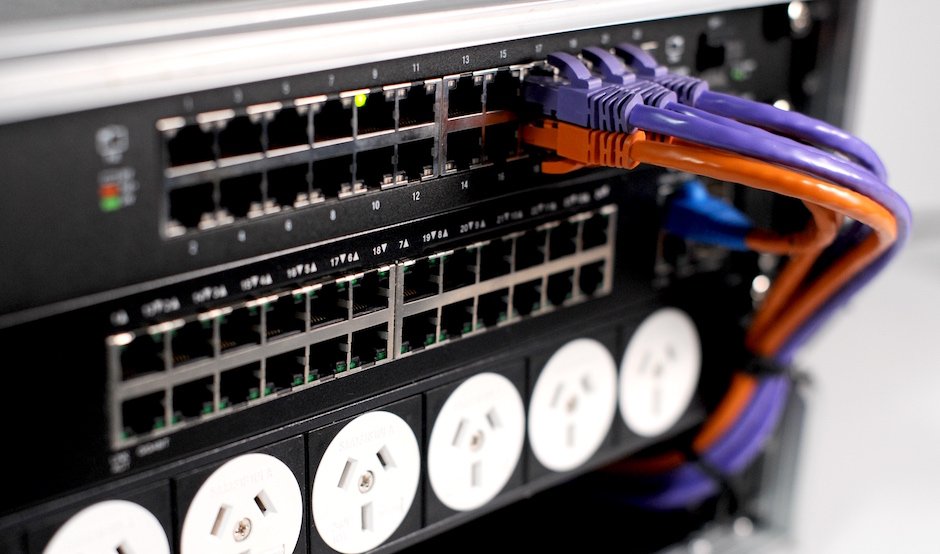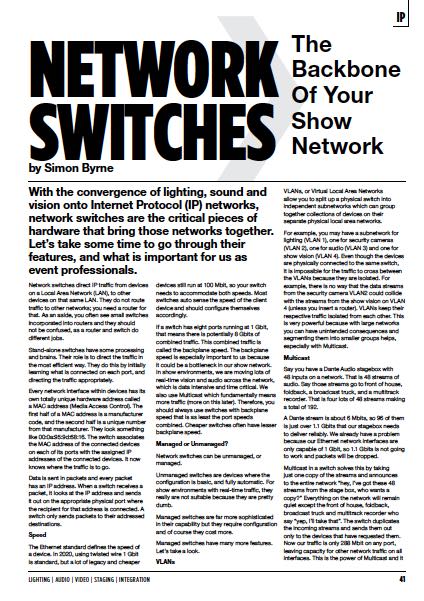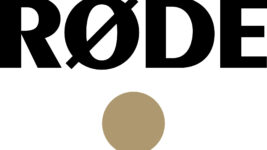IP
15 Sep 2020
Network Switches

Subscribe to CX E-News
The Backbone of your Show Network
With the convergence of lighting, sound and vision onto Internet Protocol (IP) networks, network switches are the critical pieces of hardware that bring those networks together. Let’s take some time to go through their features, and what is important for us as event professionals.
Network switches direct IP traffic from devices on a Local Area Network (LAN), to other devices on that same LAN. They do not route traffic to other networks; you need a router for that.
As an aside, you often see small switches incorporated into routers and they should not be confused, as a router and switch do different jobs.
Stand-alone switches have some processing and brains. Their role is to direct the traffic in the most efficient way. They do this by initially learning what is connected on each port, and directing the traffic appropriately.
Every network interface within devices has its own totally unique hardware address called a MAC address (Media Access Control). The first half of a MAC address is a manufacturer code, and the second half is a unique number from that manufacturer.
They look something like 00:0a:95:9d:68:16. The switch associates the MAC address of the connected devices on each of its ports with the assigned IP addresses of the connected devices. It now knows where the traffic is to go.
Data is sent in packets and every packet has an IP address. When a switch receives a packet, it looks at the IP address and sends it out on the appropriate physical port where the recipient for that address is connected.
A switch only sends packets to their addressed destinations.
Speed
The Ethernet standard defines the speed of a device. In 2020, using twisted wire 1 Gbit is standard, but a lot of legacy and cheaper devices still run at 100 Mbit, so your switch needs to accommodate both speeds.
Most switches auto sense the speed of the client device and should configure themselves accordingly. If a switch has eight ports running at 1 Gbit, that means there is potentially 8 Gbits of combined traffic. This combined traffic is called the backplane speed.
The backplane speed is especially important to us because it could be a bottleneck in our show network. In show environments, we are moving lots of real-time vision and audio across the network, which is data intensive and time critical.
We also use Multicast which fundamentally means more traffic (more on this later). Therefore, you should always use switches with backplane speed that is as least the port speeds combined. Cheaper switches often have lesser backplane speed.
Managed or Unmanaged?
Network switches can be unmanaged, or managed. Unmanaged switches are devices where the configuration is basic, and fully automatic. For show environments with real-time traffic, they really are not suitable because they are pretty dumb.
Managed switches are far more sophisticated in their capability but they require configuration and of course they cost more. Managed switches have many more features. Let’s take a look.
VLANs
VLANs, or Virtual Local Area Networks allow you to split up a physical switch into independent subnetworks which can group together collections of devices on their separate physical local area networks.
For example, you may have a subnetwork for lighting (VLAN 1), one for security cameras (VLAN 2), one for audio (VLAN 3) and one for show vision (VLAN 4).
Even though the devices are physically connected to the same switch, it is impossible for the traffic to cross between the VLANs because they are isolated. For example, there is no way that the data streams from the security camera VLAN2 could collide with the streams from the show vision on VLAN 4 (unless you insert a router).
VLANs keep their respective traffic isolated from each other. This is very powerful because with large networks you can have unintended consequences and segmenting them into smaller groups helps, especially with Multicast.
Multicast
Say you have a Dante Audio stagebox with 48 inputs on a network. That is 48 streams of audio. Say those streams go to front of house, foldback, a broadcast truck, and a multitrack recorder. That is four lots of 48 streams making a total of 192.
A Dante stream is about 6 Mbits, so 96 of them is just over 1.1 Gbits that our stagebox needs to deliver reliably. We already have a problem because our Ethernet network interfaces are only capable of 1 Gbit, so 1.1 Gbits is not going to work and packets will be dropped.
Multicast in a switch solves this by taking just one copy of the streams and announces to the entire network “hey, I’ve got these 48 streams from the stage box, who wants a copy?” Everything on the network will remain quiet except the front of house, foldback, broadcast truck and multitrack recorder who say “yep, I’ll take that”.
The switch duplicates the incoming streams and sends them out only to the devices that have requested them. Now our traffic is only 288 Mbit on any port, leaving capacity for other network traffic on all interfaces. This is the power of Multicast and it requires a process called IGMP snooping.
IGMP snooping “snoops into” or queries the incoming data packets to see if it is a Multicast. This IGMP querier then sends a broadcast to say “who wants this?” The replies come back and then the switch then only sends it to those who want it.
For this reason, there should only be one IGMP querier on a network. The implementation of IGMP does vary between manufacturers. For this reason, you should only use the one brand of switch on a show network that uses VLANs and Multicast.
Using the same brand ensures that the switches know of each other and handles the IGMP snooping properly.
By the way, I have never had a switch with Multicast configured out of the box and when a switch is reset, you lose those settings. Also, the IGMP query interval needs to be set low, say five seconds. This is the frequency that the IGMP querier checks which ports will take a Multicast. If it is set at thirty seconds, it can take that long before a path is made.
Quality of Service
Quality of Service (QoS) is an important feature of switches which prioritises traffic so that more important traffic can pass first. The result is a performance improvement for critical network traffic such as Dante audio over the other traffic that is less time critical.
Once again, the QoS feature usually needs to be configured for it to work properly.
Rapid Spanning Tree Protocol
Say you connect one port of a switch to another port on the same switch. That loop will quickly create a broadcast storm that will degrade the performance of the entire network.
This is a tricky problem. Luckily we have the Rapid Spanning Tree Protocol (RSTP) to deal with this. RSTP can be really helpful too because you can run two links between two switches (preferably the same brand) as a primary and backup.
RSTP will shut one of those links down, but should the remaining link be broken, the second one is immediately reactivated. Be aware though, this process won’t be seamless.
For seamless failover and more throughput, you want Link Aggregation.
Link Aggregation
The Link Aggregation Control Protocol (LACP) allows you to spread the traffic load across two links between two switches.
Some other devices such as network storage devices also support link aggregation. The benefits are that you can potentially get twice the speed between the devices, but more importantly in my view, if you lose one of the links, the network will continue to work seamlessly, albeit slower.
Power Over Ethernet
Oh I love Power over Ethernet (PoE). PoE delivers a DC voltage over the pairs along with the data in the single Ethernet cable. It means you do not have to power devices using a separate power supply and run less cable.
PoE is a nominally 48 volt DC supply voltage that is delivered using a similar concept to the phantom power on XLR that powers condenser microphones.
There are three standards for POE: IEEE 802.3af, 802.3at and 802.3bt which equate to supplying 15.4 watts, 30 watts and 60 watts respectively.
The DC voltage is delivered on at least two pairs of conductors in the Ethernet cable by applying a common voltage to each pair. Because twisted-pair Ethernet uses differential signalling, combined with the decent signal voltages of around five volts, the PoE does not interfere with data transmission.
All switches have a PoE budget. For example, an eight port switch may only be capable of delivering 150 watts of POE in total, so you cannot run three 60 watt devices such as PTZ cameras without running short.
Energy Efficient Ethernet
You don’t want it. Basically Energy Efficient Ethernet is a low power mode that shuts down portions of the switch that are currently not being used. The problem is that you don’t have the full capability of the switch when you need it. Turn it off.
Switch configuration can be a tricky business. I own managed switches from Cisco, Ubiquiti, Linksys, TP-Link and Netgear. They all have different menu systems and label their features slightly differently.
That makes it hard to reliably change settings because random changes will produce random effects. The good news is that we live in the world of YouTube and if you search “set up IGMP snooping in Cisco SG350”, there is bound to be a networking professional who will take you through the steps.
You could of course, also hire a networking professional to assist.
Talking from bitter experience, you shouldn’t cut costs with a switch. The more expensive brands have better hardware and engineering, also their user interface is usually better designed making it easier to understand the settings.
Don’t forget that there are some production industry switches made by brands such as Yamaha and Lumix which feature etherCON connectors and are optimised for show environments.
Don’t lose sight of the fact that the switch is probably the most critical component in your local network. If the switch underperforms, or even worse fails, you are in real trouble.
Therefore it is wise to invest in equipment that you can rely on; spending a bit extra makes sense. For show networks, I only consider the top tier brands and as I have explained, you should avoid mixing switch brands on a show network where you are using VLANs and Multicast.
Read more of Simon Byrne’s articles about networking on the CX Network:
Networking – The Cables
https://www.cxnetwork.com.au/networking-the-cables
Wifi and Data Security on Events
https://www.cxnetwork.com.au/wi-fi-and-data-security-on-events
Power Over Ethernet
https://www.cxnetwork.com.au/power-over-ethernet
Mission Critical Show Networking
https://www.cxnetwork.com.au/mission-critical-show-networking
Network Lan Scanning – See What is Going On
https://www.cxnetwork.com.au/network-lan-scanning-see-whats-going-on
Professional Video Over IP
https://www.cxnetwork.com.au/professional-video-over-ip
CX Magazine – September 2020
LIGHTING | AUDIO | VIDEO | STAGING | INTEGRATION
Entertainment technology news and issues for Australia and New Zealand
– in print and free online www.cxnetwork.com.au
© VCS Creative Publishing
Subscribe
Published monthly since 1991, our famous AV industry magazine is free for download or pay for print. Subscribers also receive CX News, our free weekly email with the latest industry news and jobs.







